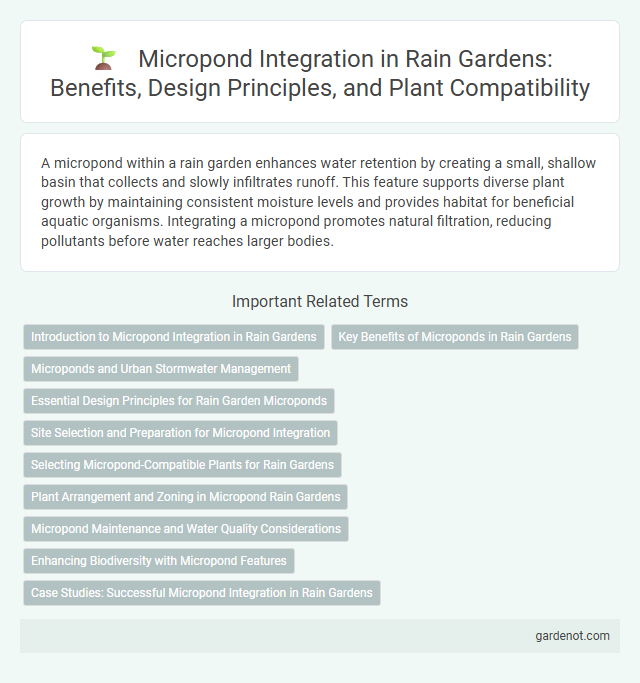A micropond within a rain garden enhances water retention by creating a small, shallow basin that collects and slowly infiltrates runoff. This feature supports diverse plant growth by maintaining consistent moisture levels and provides habitat for beneficial aquatic organisms. Integrating a micropond promotes natural filtration, reducing pollutants before water reaches larger bodies.
Introduction to Micropond Integration in Rain Gardens
Micropond integration in rain gardens enhances stormwater management by creating small, shallow ponds that temporarily store runoff, promoting sediment settling and nutrient absorption. These microponds improve infiltration rates and support diverse plant habitats, boosting overall ecological function. Their design typically incorporates native vegetation to maximize water quality benefits and biodiversity within urban or residential landscapes.
Key Benefits of Microponds in Rain Gardens
Microponds in rain gardens enhance stormwater management by capturing and slowly releasing runoff, reducing flood risks and soil erosion. They improve water quality through natural filtration by aquatic plants and microbial activity, removing pollutants such as nitrogen and phosphorous. These microhabitats also support local biodiversity by providing breeding grounds for beneficial insects, amphibians, and birds, contributing to urban ecosystem health.
Microponds and Urban Stormwater Management
Microponds serve as critical components in urban stormwater management by capturing and slowly releasing runoff, reducing flooding risks and improving water quality. These small, engineered wetlands promote sedimentation and biological filtration, effectively removing pollutants such as nitrogen, phosphorous, and heavy metals from stormwater. Integrating microponds within rain gardens enhances urban green infrastructure, contributing to sustainable water cycle restoration in cities.
Essential Design Principles for Rain Garden Microponds
Rain garden microponds require strategic placement to maximize water retention and promote infiltration, typically situated at low points where runoff accumulates. Essential design principles include ensuring appropriate soil permeability for balanced drainage and selecting native aquatic plants that support pollutant filtration and habitat diversity. Incorporating a layered substrate system with gravel and sand enhances sediment capture while maintaining micropond stability and water quality.
Site Selection and Preparation for Micropond Integration
Selecting an ideal site for micropond integration in a rain garden involves assessing topography, soil permeability, and drainage patterns to ensure optimal water retention and filtration. Site preparation requires excavation to create a shallow basin, followed by amendments like sand or compost to improve soil structure and support plant growth. Proper placement near runoff sources maximizes stormwater capture while maintaining habitat balance and avoiding waterlogging.
Selecting Micropond-Compatible Plants for Rain Gardens
Selecting micropond-compatible plants for rain gardens involves choosing species that thrive in saturated soil conditions and contribute to water filtration. Native plants such as sedges (Carex spp.), rushes (Juncus spp.), and pickerelweed (Pontederia cordata) enhance micropond ecosystems by stabilizing soil and providing habitat for aquatic life. These plants improve water absorption, reduce runoff, and increase biodiversity, making them ideal for sustainable rain garden design.
Plant Arrangement and Zoning in Micropond Rain Gardens
Micropond rain gardens utilize strategic plant arrangement and zoning to optimize water filtration and habitat diversity. Native wetland species are densely planted near the micropond edge to stabilize soil and absorb runoff pollutants, while transitional zones incorporate moisture-tolerant perennials to handle fluctuating water levels. This layered planting approach enhances nutrient uptake, supports beneficial microorganisms, and promotes sustained ecosystem health within the micropond environment.
Micropond Maintenance and Water Quality Considerations
Micropond maintenance involves regular removal of debris and sediment to prevent clogging and ensure optimal water flow within the rain garden system. Monitoring water quality focuses on reducing nutrient buildup and controlling pollutant levels to support healthy aquatic plant life and prevent algae growth. Integrating native vegetation around the micropond enhances filtration and promotes biodiversity while stabilizing water chemistry for sustainable ecosystem function.
Enhancing Biodiversity with Micropond Features
Microponds in rain gardens create crucial habitats for diverse aquatic plants and insects, significantly enhancing local biodiversity. These small water bodies support amphibians, pollinators, and beneficial microorganisms, promoting a balanced ecosystem. Incorporating micropond features improves water quality by naturally filtering runoff and nurturing a variety of species essential for sustainable urban landscapes.
Case Studies: Successful Micropond Integration in Rain Gardens
Micropond technology has proven effective in enhancing rain garden performance by improving water retention and supporting native plant growth. Case studies demonstrate that integrating microponds reduces stormwater runoff by up to 40%, promoting groundwater recharge and habitat diversity. These successful implementations highlight microponds as a sustainable solution for urban water management in rain garden designs.
Micropond Infographic

 gardenot.com
gardenot.com